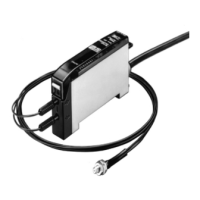E3X-NH
E3X-NH
5
J SENSITIVITY SETTING AND ADJUSTMENT
Refer to the following to select the most suitable sensitivity setting method. We recommend that two-point teaching and manual-tuning be
tried first.
Using the Sensor at the
Maximum Sensitivity
Application Examples
Detection of a passing object with
through-beam fibers.
Checking IC T ray Arrangements
E3X-NH
Sensing Slight Differences
Application Examples
Detection of slight differences in
reflection.
Detection of translucent objects.
Detection of object surface irregu-
larities.
Color discrimination.
Detecting IC Chips on Film Sheet
E3X-NH
E32-T16P
Sensitivity Setting
Without Objects
Application Examples
Detection of minute passing ob-
jects.
Detection of lead wires.
High-precision positioning.
Detecting Lead Frame Position
E32-D32
Lead frame
Fine -tuning on Production Lines
Reason
Marginal sensitivity adjustment is required considering the
differences in targets.
For high-precision positioning of electronic parts.
Detecting
Lead Frame Rises
E3X-NH
Ideal Operation Under Frequently Changing
Environments
Reason
Dust sticking to the fiber tip.
Targets are slightly different from each other in color or
surface quality.
Detecting
Passing Chip Parts
E3X-NH
E32-T16P
Auto-tuning (Automatic Sensitivity Compensation)
Fine-tuning, if required.
E32-T24
Detecting
Cassette Tape Cases
Ensuring reliable detection
without being influenced by
the difference in color or
mark.
E3X-NH
E32-L25A
3.3 mm
Counting
Number Of Pills
Sensitivity Setting
Film sheet
Sensitivity Adjustment (Fine -tuning)
Maximum Sensitivity Setting One-point Teach ModeTwo-point Teach Mode
Manual-tuning (Fine Sensitivity Adjustment)

